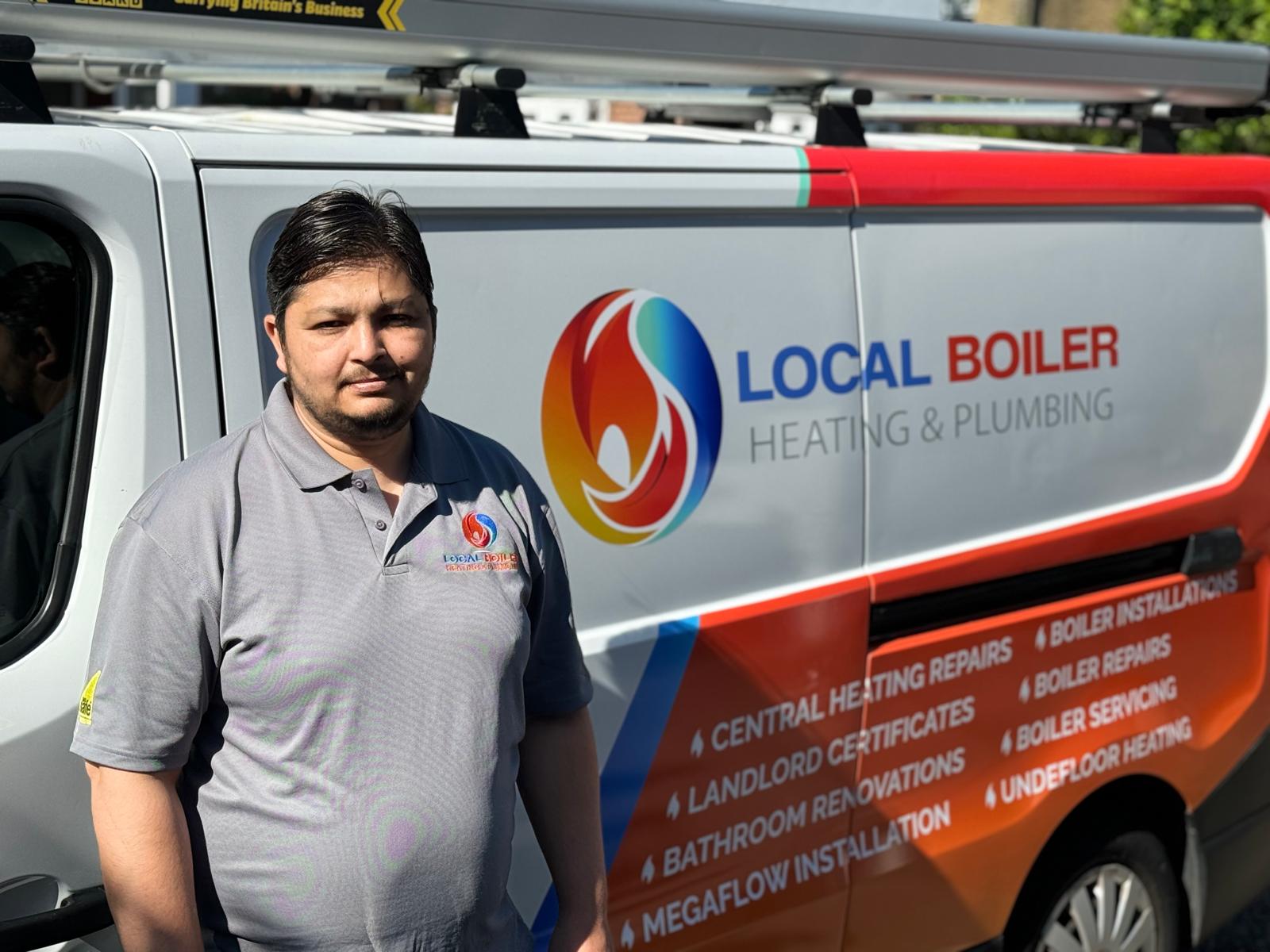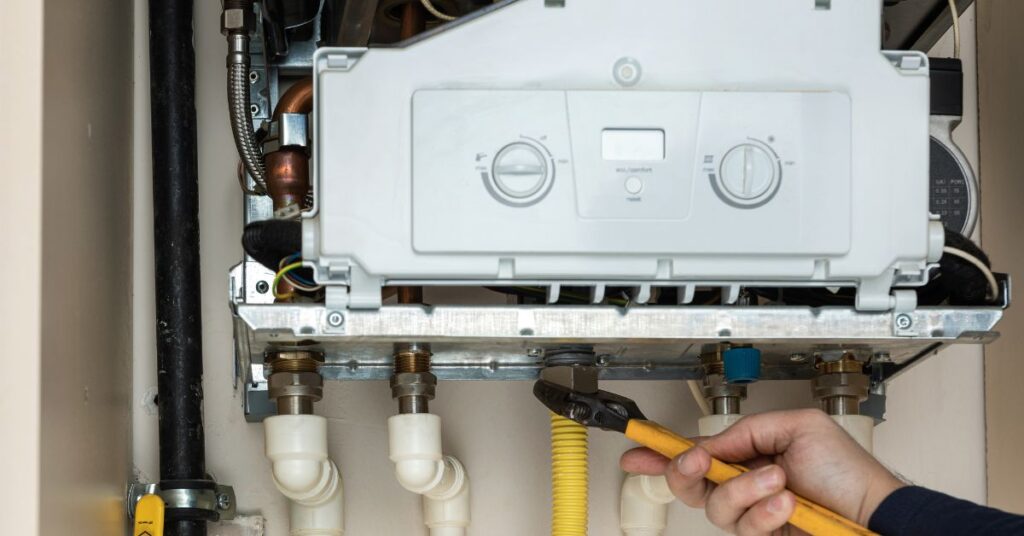Introduction
The combination boiler has become a staple in many homes in the UK. It offers hot water on demand without the need for a separate tank. But combi boiler owners are all too familiar with the occasional problem of a weak shower. There’s nothing more annoying than starting the day with dribbling instead of drenching!
We’ve all asked ourselves at one time or another: “Can you fit a shower pump to a combi boiler?” In this definitive guide, we’ll find out. We’ll cover:
- Why does pressure loss happen
- What shower pumps are
- Can you actually fit one to a combi
- Professional solutions for boosting combi shower pressure
- DIY checks to try first
- Costs
- Safety and legal advice
- Installation considerations
By the end, you’ll know the whole story. But first…
Understanding Combi Boilers and Water Flow
1. How Combi Boilers Work
The boiler, commonly referred to as a combi or combination boiler, is a compact, wall-mounted unit that provides both heating and instant hot water. There’s no separate hot water storage tank or cylinder like in older boiler systems. Instead, the combi heats mains water directly from the pipes on demand. When you turn on a tap or shower, water travels from the mains through the boiler, where it’s heated by an element and then delivered to the outlet.
Hot water is heated as needed, “on demand,” rather than being stored in a cylinder. This is convenient, but it does limit performance if the mains pressure is weak.
2. Why Mains Pressure Affects Shower Flow
With no storage tank to release pressure from, a combi boiler relies on mains water pressure to push water through the pipes. If mains pressure is poor in your area or household, your shower will suffer.
Factors such as the age of water pipes, peak demand times, and distance from the mains all impact water flow. Other homes on a shared supply in an apartment building can further reduce performance.
3. Flow Rate Limitations in a Typical UK Home
Most homes have mains water pressure, allowing for a flow of about 8–12 litres per minute (LPM) through a single tap or shower. Standard combi boilers can often cope with 10–15 LPM, depending on the model. However, other simultaneous demands, such as running a washing machine, dishwasher, or multiple bathrooms, can compete for the available water, leaving your shower with a trickle.
What is a Shower Pump?
1. Definition and Purpose
A shower pump is a device that increases the water pressure and flow in your hot and cold water system. It “boosts” the water coming through your pipes for a stronger shower.
2. Types of Shower Pumps
- Single impeller pumps work on either the hot or cold water supply only. These are for smaller homes or single showers.
- Twin impeller pumps increase pressure on both hot and cold lines simultaneously. These are for larger bathrooms with multiple shower heads or users.
- Mains booster pumps raise the water pressure on the incoming main supply to the house.
3. How They Increase Water Pressure
A shower pump works by drawing water from the existing supply and using an electric motor to force it through the pipes at a higher pressure. This increased flow is immediately noticeable and can make a massive difference if you have a gravity-fed system with low pressure. For a combi boiler shower, the pump helps to overcome weak mains pressure for better performance.
Can You Fit a Shower Pump to a Combi Boiler?
1. Legal and Technical Restrictions
The simple answer is that you cannot (legally or safely) directly fit an electric shower pump to a combi boiler. Standard electric shower pumps are not designed to attach to the hot water outlet of a combi boiler.
Legally, this is because a combi boiler requires a minimum flow rate to operate safely and pump feedback into it can:
- Void the warranty
- Damage internal components
- Create illegal plumbing practices.
2. Electric Shower Pumps vs Gravity-Fed Systems
Shower pumps were designed for older gravity-fed water systems, where the water comes from a tank in the loft. A combi boiler system already has the water at mains pressure, so forcing more water into it via a pump can create unsafe conditions.
3. Alternatives to Direct Pump Fitting
The alternative for boosting a combi boiler shower safely is:
- Twin shower pumps, installed in tandem with an accumulator tank, provide a safe pressure boost.
- Accumulator tanks: A small pressurised tank stores water, allowing the combi to draw at a higher flow rate.
- Pressure-boosting valves, fitted on the mains supply, regulate and increase pressure as required.
These solutions are safe and legal, but will typically require a professional engineer for installation in most cases.
Professional Solutions for Boosting Combi Boiler Shower Pressure
1. Installing Mains Booster Pumps (Legally)
One way to legally increase the water pressure to your shower is to fit a mains booster pump. These devices raise the pressure on the incoming water supply before it reaches the combi boiler. Mains booster pumps are specifically designed to work with mains-fed systems.
Please note that this solution is permitted under UK plumbing regulations when installed correctly by a qualified professional.
2. Adding an Accumulator Tank
Accumulator tanks are small pressure vessels that store a volume of hot water at higher pressure. They allow the combi boiler to release water at a more powerful rate into the shower. The tank automatically fills from the main water supply and releases into the system as needed.
A common and effective solution is to fit an accumulator tank with twin impeller pumps. This is particularly popular in flats and homes with multiple bathrooms.
3. Upgrading to a Higher kW Combi Boiler
A larger issue sometimes is that the boiler is simply undersized. Upgrading to a higher kW (kilowatt) combi boiler can deliver improved heating and shower flow, especially in larger homes or when there is high simultaneous demand from multiple taps and showers.
Case Examples
- London flats often have lower mains pressure and smaller diameter pipes. A popular and safe solution is to install an accumulator tank in conjunction with twin impeller pumps.
- Detached houses: With larger pipework and higher flow rates, they can more easily accommodate a mains booster pump or benefit from a boiler upgrade.
DIY Checks Before Considering a Pump
- Test mains water pressure: Measure your mains pressure with a pressure gauge or contact your local water supplier. The average mains pressure is 2.75 to 4.5 bar.
- Check shower heads for blockages: Mineral scale and deposits can accumulate over time in shower heads, reducing the flow. Remove the shower head and soak it in vinegar to dissolve limescale.
- Inspect stopcocks and valves: Ensure that all stopcocks and valves are fully open and functioning correctly.
- Determine if low pressure is a household-wide issue: Low pressure only in your shower could indicate internal plumbing issues. Check taps in other rooms to determine if the issue is specific to the shower or a whole-house problem.
These checks are worth doing first to help diagnose the cause of the low shower pressure before trying more complex solutions.
Costs and Installation Considerations
1. Approximate Costs
- Shower pumps: £150–400 for unit
- Accumulator tanks: £200–600 depending on size and pressure rating
- Boiler upgrades: £1500–3000 for a higher kW combi boiler, including install
2. Labour and Call-Out Fees in London
- Call-out fees: £80–120
- Hourly labour: £50–80 per hour
- Complex installations like mains booster pumps for flats will increase costs
3. Safety Considerations
- Always hire a Gas Safe registered engineer to install or work on boilers or pumps
- Check that the electrical connections for pumps meet UK safety standards
- Never try DIY modifications inside the boiler, which can be dangerous and illegal
Also Read: – Is a combi boiler better than a system boiler
Frequently Asked Questions (FAQs)
Is it safe to fit a shower pump to a combi boiler?
Directly no. Standard shower pumps are not designed for use on mains-fed combi boilers. Accumulator tanks and mains booster pumps are legal and safe alternatives.
Will a pump damage my boiler?
Yes. The wrong type of pump can damage your boiler, void the warranty, and lead to unsafe pressure situations.
Are twin impeller pumps better than single impeller pumps?
Twin pumps increase both hot and cold water simultaneously, making them ideal for use with more than one shower or tap. Single pumps only affect one water supply.
Can I boost shower pressure without a pump?
Suppose your issue is slight, sometimes yes. Cleaning shower heads, opening valves, and checking mains pressure are simple steps. For severe low pressure, a professional solution, such as a pump or accumulator tank, is usually required.
Conclusion
Can you fit a shower pump to a combi boiler? Directly, no. Standard shower pumps should not be attached to the hot outlet of a combi boiler. Doing so will void the warranty, damage the boiler, and lead to illegal plumbing practices.
However, there are safe alternatives that can effectively boost your combi boiler shower pressure. We’ve covered professional solutions like mains booster pumps, accumulator tanks, and upgrading to a higher kW combi boiler. Each has pros and cons depending on your exact situation.
Always carry out basic DIY checks first. And consult a Gas Safe registered engineer before beginning any installation work. Proper professional advice and installation are essential to ensure safety and avoid voiding your boiler warranty. Get in touch today to speak with a friendly expert who can advise you on the right way to safely and effectively boost your combi boiler shower pressure.

Sunny Saini is a certified heating engineer with over 15 years of experience in maintaining and repairing boilers. He specializes in diagnosing complex boiler issues and providing reliable solutions to ensure homeowners stay warm and comfortable throughout the year.





![]=](https://localboiler.co.uk/wp-content/uploads/2024/05/Untitled-design-96-300x300.jpg)